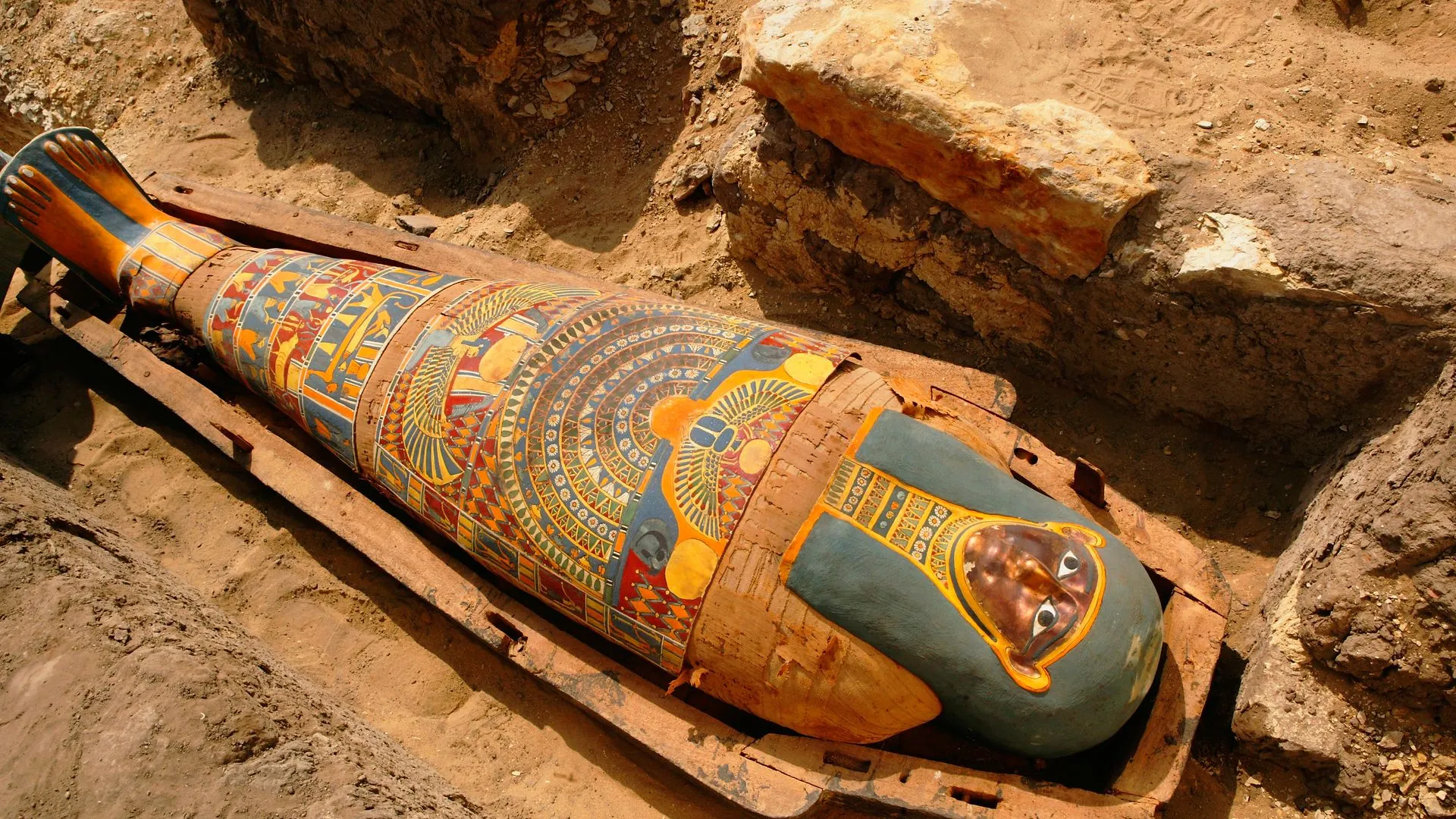
Smelling an ancient mummy is ‘quite pleasant,’ may offer insight: Study
By Craig Nigrelli (Anchor), Evan Hummel (Producer), Shianne DeLeon (Video Editor)
- Slovenian researchers are sniffing the sarcophagi of ancient Egyptian mummies in hopes of learning more about the embalming practice, according to a new study published on Thursday, Feb. 13. Researchers described the smells as woody, spicy and sweet as reported by The Associated Press.
- Scientists used chemical analysis and a group of “human sniffers” to help determine the odors from nine mummies up to 5,000 years old that were in storage or on display at the Egyptian Museum in Cairo.
- Researchers sought to examine scent, as it was a vital element in the mummification process. This process utilized oils, waxes, and balms to preserve the body and its spirit for the afterlife.
Full Story
Sniffing an ancient corpse may sound taboo, but for those curious, Slovenian researchers revealed well-preserved Egyptian mummies smell quite nice. Researchers sought to examine scent, as it was a vital element in the mummification process.
Media Landscape
This story is a Media Miss by the right as only 13% of the coverage is from right leaning media. Learn moreBias Summary
- A study reveals that ancient Egyptian mummies emit pleasant aromas, described as "woody," "spicy" and "sweet," based on research conducted at University College London and the University of Ljubljana.
- The researchers analyzed mummies, some dating back 5,000 years, using gas chromatography and trained human sniffers to identify the scents and their sources.
- The study indicated that no microbial degradation was present, suggesting effective preservation of the mummies.
- Mummification was a complex ritual aimed at preserving the body and soul for the afterlife, employing various oils and resins that contribute to the pleasant scents.
- No summary available because of a lack of coverage.
- No summary available because of a lack of coverage.
Bias Distribution
Left
Right
Right
Untracked Bias
What did they smell like?
The top descriptions ranged from “woody,” “spicy” and “sweet” as well as other aromas, according to sniff testers.

Download the SAN app today to stay up-to-date with Unbiased. Straight Facts™.
Point phone camera here
“The note floral probably indicates some of the mummification materials were plant-based, such as resinous ore,” said Matija Strlic, a researcher with the University of Ljubljana. “And these resin, these resins could be, for example, from pine trees or juniper and similar, so in general, many of these mummification materials have quite a pleasant smell.”
The findings come from a study published on Thursday, Feb. 13, in the Journal of the American Chemical Society.
Scientists used chemical analysis and a group of “human sniffers” to help determine the odors from nine mummies up to 5,000 years old that were in storage or on display at the Egyptian Museum in Cairo.
Why are they sniffing sarcophagi and ancient materials?
Researchers aimed to investigate the scents because they were a critical factor in the mummification process, which involved oils, waxes and balms to preserve the body and its spirit for the afterlife.
Scientists have stated that this practice was primarily reserved for pharaohs and nobility. Pleasant aromas were thought to signify purity, whereas foul odors were considered signs of corruption.
Researchers did not sample the mummies due to ethical concerns.
However, they were able to determine whether the smells originated from an archaeological object or from decay caused by mold, bacteria or other factors by using tools to measure air molecules emanating from the sarcophagi, thus assessing the state of preservation.
What did they find?
“We were quite worried that we might find notes or hints of decaying bodies, which wasn’t the case,” Strlic said.
He continued, “We were specifically worried that there might be indications of microbial degradation or microbiological degradation, but that wasn’t the case, which means that the environment in this museum is actually quite good in terms of preservation.”
German postdoctoral researcher Barbara Huber, who was not part of this study, told the AP that the findings could provide important information on compounds that better preserve mummified remains. She said the research could someday be used to protect ancient bodies for generations to come.
Huber did author a study two years ago that examined residue from a jar that had mummified organs from an ancient noblewoman in order to identify embalming ingredients and their origins, which uncovered information about trade routes.
Huber then worked with a perfumer to create a similar smell from the identified ingredients called “Scent of Eternity.” It is now accessible to museum visitors in Denmark for their smelling enjoyment.
Get up to speed on the stories leading the day every weekday morning. Sign up for the newsletter today!
Learn more about our emails. Unsubscribe anytime.
By entering your email, you agree to the Terms & Conditions and acknowledge the Privacy Policy.
What do they plan to do with the findings?
Researchers involved in the latest study hope their findings can achieve a similar effect by recreating the scents they detected through what are known as “smellscapes” for future museum visitors.
Cecilia Bembibre, a lecturer at University College London, said, “Museums have been called white cubes, where you are prompted to read, to see, to approach everything from a distance with your eyes. However, when we experience the world, we use our five senses and we believe there was value specifically in such a collection, in such a heritage, in understanding what was the significance of the smell to their value, to the public, to their value for conservation, so we can ensure that we can leave this heritage for future generations in its entirety.”
[CRAIG NIGRELLI]
SNIFFING AN ANCIENT CORPSE MAY SOUND TABOO BUT FOR THOSE WHO ARE CURIOUS SLOVENIAN RESEARCHERS HAVE REVEALED WELL-PRESERVED EGYPTIAN MUMMIES SMELL QUITE NICE.
THE TOP DESCRIPTIONS RANGED FROM “WOODY,” “SPICY AND “SWEET” AS WELL AS OTHER AROMAS, ACCORDING TO SNIFF TESTERS.
[MATIJA STRLIC]
“THE NOTE FLORAL PROBABLY INDICATES SOME OF THE MUMMIFICATION MATERIALS WERE PLANT BASED, SUCH AS RESINIOUS ORE. AND THESE RESIN, THESE RESINS COULD BE, FOR EXAMPLE, FROM PINE TREES OR JUNIPER AND SIMILAR. SO IN GENERAL, MANY OF THESE MUMMIFICATION MATERIALS HAVE QUITE A PLEASANT SMELL.”
[CRAIG NIGRELLI]
THE FINDINGS COME FROM A STUDY PUBLISHED THURSDAY IN THE JOURNAL OF THE AMERICAN CHEMICAL SOCIETY.
SCIENTISTS USED CHEMICAL ANALYSIS AND A GROUP OF “HUMAN SNIFFERS” TO HELP DETERMINE THE ODORS FROM NINE MUMMIES UP TO FIVE-THOUSAND YEARS OLD THAT WERE IN STORAGE OR ON DISPLAY AT THE EGYPTIAN MUSEUM IN CAIRO.
RESEARCHERS WANTED TO STUDY THE SCENTS BECAUSE IT WAS A CRUCICAL FACTOR IN THE MUMMIFICATION PROCESS WHICH USED OILS, WAXES AND BALMS TO PRESERVE THE BODY AND ITS SPIRIT IN THE AFTERLIFE.
SCIENTISTS SAY THE PRACTICE WAS MOSTLY RESERVED FOR PHARAOHS AND NOBILITY AS PLEASANT AROMAS WERE BELIEVED TO SIGNAL PURITY WHILE BAD ODORS WERE THOUGHT TO BE SIGNS OF CORRUPTION.
RESEARCHERS DID NOT SAMPLE THE MUMMIES THEMSELVES OVER ETHICAL CONCERNS.
THEY WERE ABLE TO DETERMINE WHETHER THE SMELLS CAME FROM AN ARCHEOLOGICAL ITEM OR FROM DECAY DUE TO MOLD, BACTERIA OR OTHER FACTORS BY USING TOOLS TO MEASURE AIR MOLECULES COMING FROM THE SARCOPHAGI TO DETERMINE THE STATE OF PRESERVATION.
[MATIJA STRLIC]
WE WERE QUITE WORRIED THAT WE MIGHT FIND NOTES OR HINTS OF DECAYING BODIES, WHICH WASN’T THE CASE. WE WERE SPECIFICALLY WORRIED THAT THERE MIGHT BE INDICATIONS OF MICROBIAL DEGRADATION OR MICROBIOLOGICAL DEGRADATION, BUT THAT WAS NOT THE CASE, WHICH MEANS THAT THE ENVIRONMENT IN THIS MUSEUM IS ACTUALLY QUITE GOOD IN TERMS OF PRESERVATION.
[CRAIG NIGRELLI]
GERMAN POSTDOCTORAL RESEARCHER BARBARA HUBER, WHO WAS NOT PART OF THIS STUDY, TOLD THE ASSOCIATED PRESS THE FINDINGS COULD PROVIDE IMPORTANT INFORMATION ON COMPOUNDS THAT BETTER PRESERVE MUMMIFIED REMAINS.
SHE SAYS THE RESEARCH COULD BE USED TO PROTECT ANCIENT BODIES FOR GENERATIONS TO COME.
HUBER DID AUTHOR A STUDY TWO YEARS AGO WHICH EXAMINED RESIDUE FROM A JAR THAT HAD MUMMIFIED ORGANS FROM AN ANCIENT NOBLEWOMEN IN ORDER TO IDENTIFY EMBALMING INGREDIENTS AND THEIR ORIGINS, WHICH UNCOVERED INFORMATION ABOUT TRADE ROUTES.
HUBER THEN WORKED WITH A PERFUMER TO CREATE A SIMILAR SMELL FROM THE IDENTIFIED INGREDIENTS CALLED “SCENT OF ETERNITY” NOW AVAILABLE TO MUSEUMGOERS IN DENMARK FOR THEIR SNIFFING-PLEASURE.
RESEARCHERS WITH THE LATEST STUDY HOPE THEIR FINDINGS CAN DO SOMETHING SIMILAR BY RECREATING THE SCENTS THEY DETECTED THROUGH SO-CALLED “SMELL SCAPES” FOR FUTURE MUSEUM VISITORS.
[CECILIA BEMBIBRE]
WHEN WE EXPERIENCE THE WORLD, WE USE OUR FIVE SENSES AND WE BELIEVE THERE WAS VALUE SPECIFICALLY IN SUCH A COLLECTION, IN SUCH A HERITAGE, IN UNDERSTANDING WHAT WAS THE SIGNIFICANCE OF THE SMELL TO THEIR VALUE, TO THE PUBLIC, TO THEIR VALUE FOR CONSERVATION, SO WE CAN ENSURE THAT WE CAN LEAVE THE HERITAGE FOR FUTURE GENERATIONS IN ITS ENTIRETY.
[CRAIG NIGRELLI]
FOR MORE ON THIS STORY– DOWNLOAD THE STRAIGHT ARROW NEWS APP OR VISIT SAN DOT COM.
Media Landscape
This story is a Media Miss by the right as only 13% of the coverage is from right leaning media. Learn moreBias Summary
- A study reveals that ancient Egyptian mummies emit pleasant aromas, described as "woody," "spicy" and "sweet," based on research conducted at University College London and the University of Ljubljana.
- The researchers analyzed mummies, some dating back 5,000 years, using gas chromatography and trained human sniffers to identify the scents and their sources.
- The study indicated that no microbial degradation was present, suggesting effective preservation of the mummies.
- Mummification was a complex ritual aimed at preserving the body and soul for the afterlife, employing various oils and resins that contribute to the pleasant scents.
- No summary available because of a lack of coverage.
- No summary available because of a lack of coverage.
Bias Distribution
Left
Right
Right
Untracked Bias
Straight to your inbox.
By entering your email, you agree to the Terms & Conditions and acknowledge the Privacy Policy.
MOST POPULAR
-
 AP Images
AP Images
Minnesota ‘TDS’ bill sponsor arrested for allegedly soliciting teen
Read9 hrs ago -
 Getty Images
Getty Images
USPS employee found guilty of stealing more than $1.6 million in checks
Read12 hrs ago -
 Getty Images
Getty Images
China pushes back on BlackRock Panama Canal deal lauded by Trump
Watch 2:5013 hrs ago -
 Getty Images
Getty Images
Some federal workers report ‘chaos’ as federal return-to-office begins
Watch 2:2315 hrs ago




